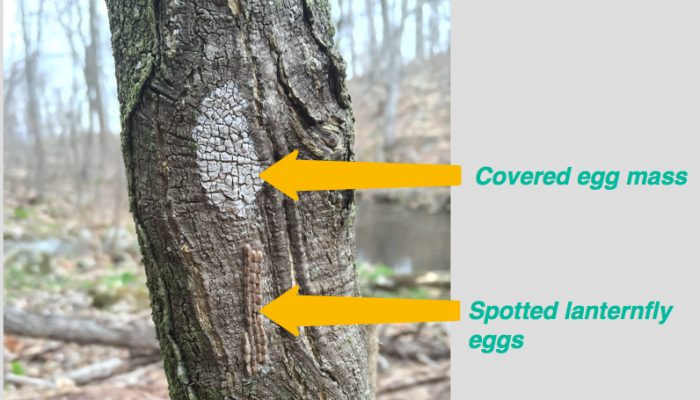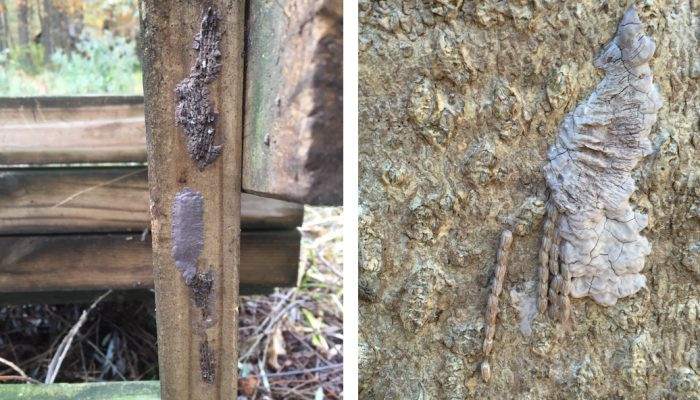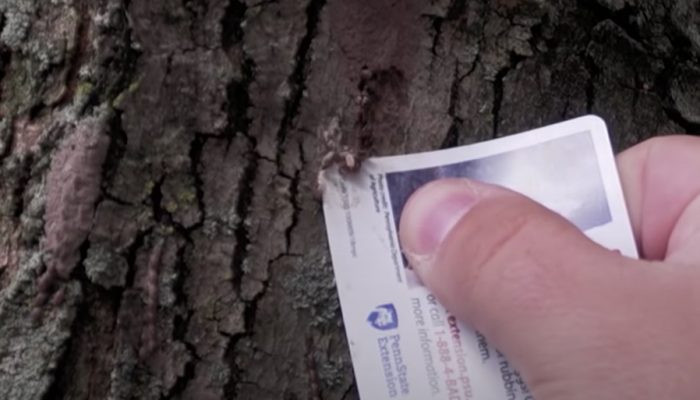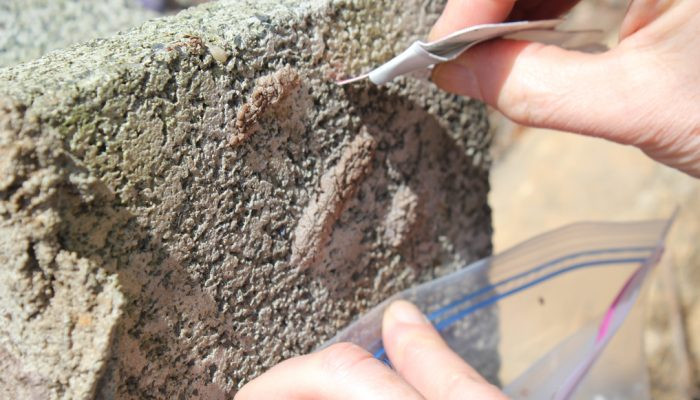Spotted lanternfly eggs look like grayish, mud-like coverings on trees and other surfaces, typically about an inch long and 3/4 of an inch wide, concealing 30 to 50 eggs. You can protect valuable plants and trees by understanding the appearance, location, and proper removal methods, helping to control their population and protect our ecosystem with the help of flyermedia.net. This guide will cover what spotted lanternfly eggs look like, where to find them, and the most effective methods for destroying them, helping you take action against this invasive species and improve pest management in your garden, and the overall protection of trees and other agriculture.
1. Identifying Spotted Lanternfly Eggs: What To Look For
Identifying spotted lanternfly eggs is crucial for controlling their population and protecting plants and trees. So, what exactly do these eggs look like?
- Appearance: Spotted lanternfly egg masses are typically about an inch long and 3/4 of an inch wide.
- Color and Texture: They appear as light grayish splotches of mud, cement, or lichen when dried.
- Protective Coating: The female lanternfly secretes a white, waxy substance over the eggs to protect them, which hardens over time.
- Egg Count: Each mass holds approximately 30 to 50 eggs.
 Spotted lanternfly egg mass and exposed eggs
Spotted lanternfly egg mass and exposed eggs
Photo: Emelie Swackhamer, Penn State Extension.
2. When and Where To Find Spotted Lanternfly Eggs
Knowing when and where to find spotted lanternfly eggs is key to managing these pests effectively. So, where do they lay eggs and when is the best time to look?
-
Timing: Spotted lanternfly egg masses can be found from September to June.
-
Protected Locations: Lanternflies lay eggs in areas sheltered from wind and harsh winters.
-
Common Sites: Look for egg masses on tree trunks, the undersides of tree branches, rocks, outdoor sheds, equipment, and any other sheltered surface.
Location Description Tree Trunks Inspect the main support of trees, paying close attention to crevices and rough bark. Undersides of Branches Check the bottom of limbs where egg masses are less exposed to rain and sun. Rocks Look under and on the sides of stones, particularly in wooded or garden areas. Outdoor Structures Examine sheds, fences, and other constructions for egg masses attached to the sides or undersides. Equipment Check any machinery or tools left outdoors, focusing on parts that offer cover. Sheltered Surfaces Broad term including any area protected from the elements, like under eaves or within stacked materials.
 Egg masses on a bench post and close-up
Egg masses on a bench post and close-up
Egg masses on a bench post (left) and close-up (right). Photos: Emelie Swackhamer, Penn State Extension.
3. Effective Methods for Destroying Spotted Lanternfly Eggs
Once you’ve located the egg masses, destroying them is essential to reduce the population of spotted lanternflies. What are the recommended methods for destroying these eggs?
3.1. Method 1: Crushing
- How to Crush: Use a credit card, putty knife, or another hard implement to crush the eggs.
- Technique: Drag the tool across the egg mass with firm pressure.
- Confirmation: You’ll know you’ve been successful when the eggs pop and release liquid.
3.2. Method 2: Scraping
- Prepare a Bag: Fill a plastic bag with a few ounces of rubbing alcohol or hand sanitizer.
- Scrape the Eggs: Use a credit card, putty knife, or butter knife to scrape the eggs off the surface into the bag.
- Ensure Contact: Make sure the eggs come into contact with the alcohol/sanitizer. The eggs must remain submerged in the alcohol solution to ensure they are killed.
- Dispose Properly: Take the bag, place it in another bag, and discard it in the trash.
 Crush lanternfly egg masses with a credit card or other flat item
Crush lanternfly egg masses with a credit card or other flat item
Crush lanternfly egg masses with a credit card or other flat item. Photo: Penn State Extension video.
 Scrape egg masses into a bag filled with some alcohol or sanitizer
Scrape egg masses into a bag filled with some alcohol or sanitizer
Scrape egg masses into a bag filled with some alcohol or sanitizer. Photo: Nancy Bosold, Penn State Extension.
4. Why Is It Important To Destroy Spotted Lanternfly Eggs?
Destroying spotted lanternfly eggs is vital because it directly reduces the population of this invasive species, which poses a significant threat to trees, plants, and agriculture. By eliminating the eggs, you prevent the nymphs from hatching and causing damage.
5. What Are The Impacts Of Spotted Lanternfly?
Spotted Lanternflies (SLF) are a serious threat to plant health in the USA. Here’s a breakdown of their impacts:
5.1. Agricultural Damage
SLF can cause significant damage to crops, costing farmers money and potentially impacting food supply.
- Feeding Habits: SLF feed on plant sap, weakening the plant and making it more susceptible to diseases and other pests.
- Honeydew Production: They excrete a sugary substance called honeydew, which promotes the growth of sooty mold. This mold can cover leaves, hindering photosynthesis and further weakening the plant.
5.2. Impacted Plants
SLF targets a wide range of plants, including:
- Fruit trees (apples, peaches, grapes)
- Hardwood trees (maple, oak, walnut)
- Grapevines
- Hops
- Other ornamental plants
5.3. Economic Consequences
Beyond direct crop damage, SLF infestations can lead to:
- Increased costs for pest control: Farmers and homeowners need to spend money on insecticides and other control methods.
- Quarantine restrictions: Areas with SLF infestations may face restrictions on the movement of goods, impacting businesses and trade.
- Loss of tourism: Heavily infested areas may become less appealing to tourists.
5.4. Environmental Effects
The sugary honeydew excreted by SLF can attract other insects like ants and wasps, disrupting the local ecosystem. Sooty mold growth on plants also reduces their ability to photosynthesize, impacting their health and potentially affecting air quality.
6. What to Do If You Find a Spotted Lanternfly Egg Mass
If you find a spotted lanternfly egg mass, it’s important to take immediate action to help control the spread of this invasive species. What steps should you take upon discovery?
- Identify the Egg Mass: Confirm that what you’ve found is indeed a spotted lanternfly egg mass. Remember, they look like light grayish splotches of mud, cement, or lichen, typically about an inch long and 3/4 of an inch wide.
- Destroy the Egg Mass: Use one of the methods described earlier—crushing or scraping—to destroy the eggs.
- Report the Sighting: Report your finding to your local Department of Agriculture or Extension office. This helps officials track the spread of the spotted lanternfly and implement effective control measures.
- Inspect Surrounding Areas: Check nearby trees, rocks, and structures for additional egg masses.
- Spread the Word: Educate your neighbors and community about the spotted lanternfly and the importance of destroying egg masses.
7. Can You Mistake Other Insects for Spotted Lanternfly?
Yes, it is possible to mistake other insects or their egg masses for spotted lanternfly eggs. So, what other insects could be confused with spotted lanternflies?
7.1. Mud Dauber Wasps
- Appearance: Mud dauber wasps build nests made of mud that can resemble spotted lanternfly egg masses.
- Distinguishing Features: Mud dauber nests are typically more structured and symmetrical than the irregular shape of lanternfly egg masses. Also, they lack the waxy coating found on lanternfly eggs.
7.2. Gypsy Moth Eggs
- Appearance: Gypsy moth eggs are laid in masses covered with tan or buff-colored hairs, which can sometimes be mistaken for the mud-like appearance of spotted lanternfly eggs.
- Distinguishing Features: Gypsy moth egg masses are usually more compact and have a fuzzy texture due to the hairs, while spotted lanternfly egg masses have a smoother, mud-like appearance.
7.3. Lichen
- Appearance: Lichen, a symbiotic organism consisting of fungi and algae, can grow on trees and rocks, sometimes resembling the grayish color and texture of spotted lanternfly egg masses.
- Distinguishing Features: Lichen usually has a more irregular and textured surface than the relatively smooth surface of lanternfly egg masses. Also, lichen is attached more firmly to the surface and cannot be easily scraped off.
8. What Are The Natural Predators Of The Spotted Lanternfly?
Several natural predators have been observed preying on spotted lanternflies, which may help in controlling their populations naturally. What animals eat spotted lanternflies?
-
Birds: Birds such as chickens, ducks, and wild birds like starlings and grackles have been seen feeding on spotted lanternflies.
-
Insects: Certain insects, including praying mantises and assassin bugs, are known to prey on spotted lanternflies.
-
Spiders: Spiders can also capture and consume spotted lanternflies, particularly the nymphs.
Predator Prey Stage Effectiveness Chickens Adults, Nymphs High, especially in controlled environments. Ducks Adults, Nymphs High, effective in larger areas. Starlings Adults, Nymphs Moderate, contributes to natural control. Praying Mantises Nymphs Moderate, hunts smaller stages. Assassin Bugs Nymphs Moderate, effective ambush predators. Spiders Nymphs Low to Moderate, captures opportunistic prey.
9. Can Spotted Lanternfly Fly Long Distances?
Yes, spotted lanternflies can fly long distances, which contributes to their rapid spread.
- Flight Range: Adult spotted lanternflies are capable of flying several miles at a time, allowing them to quickly colonize new areas.
- Aided by Wind: They can also be carried by the wind, further increasing their dispersal range.
10. Latest Spotted Lanternfly Research and Control
Stay informed about the most up-to-date information on spotted lanternfly research and control methods.
10.1. Research on Biological Control
- Fungal Pathogens: Scientists are researching the use of fungal pathogens that specifically target spotted lanternflies. These pathogens can be applied as a bio-insecticide to control infestations.
- Parasitoid Wasps: Research is being conducted on parasitoid wasps that lay their eggs inside spotted lanternfly eggs, killing them.
10.2. Chemical Control Methods
- Insecticides: Various insecticides are effective against spotted lanternflies, but it’s important to use them responsibly to minimize harm to beneficial insects and the environment.
- Tree Banding: Applying sticky bands around tree trunks can trap nymphs as they climb, preventing them from reaching the canopy.
10.3. Public Awareness and Education
- Citizen Science: Encouraging the public to report sightings and destroy egg masses helps in tracking and controlling the spread of spotted lanternflies.
- Educational Programs: Extension services and government agencies provide educational programs to inform people about the spotted lanternfly and how to manage it.
11. Will Spotted Lanternflies Die In The Winter?
Adult spotted lanternflies do not survive the winter.
- Egg Overwintering: Only the eggs of the spotted lanternfly survive through the winter.
- Adult Lifespan: Adults typically die off with the onset of cold weather, which is why destroying egg masses in the fall and winter is so critical.
12. Can Spotted Lanternfly Kill Trees?
While spotted lanternflies are unlikely to kill trees directly, they can weaken them, making them more susceptible to other stressors.
- Weakening Trees: By feeding on tree sap, spotted lanternflies reduce the tree’s energy reserves, which can lead to reduced growth and overall health.
- Increased Vulnerability: Weakened trees are more vulnerable to diseases, pests, and environmental stresses like drought.
13. Spotted Lanternfly FAQs
13.1. What do spotted lanternfly eggs look like?
Spotted lanternfly eggs look like light grayish splotches of mud, cement, or lichen, typically about an inch long and 3/4 of an inch wide.
13.2. Where can I find spotted lanternfly eggs?
You can find spotted lanternfly egg masses on tree trunks, the undersides of tree branches, rocks, outdoor sheds, equipment, and any other sheltered surface.
13.3. When is the best time to look for spotted lanternfly eggs?
The best time to look for spotted lanternfly egg masses is from September to June.
13.4. How do I destroy spotted lanternfly eggs?
You can destroy spotted lanternfly eggs by crushing them with a hard object or scraping them into a bag filled with rubbing alcohol or hand sanitizer.
13.5. Why is it important to destroy spotted lanternfly eggs?
Destroying spotted lanternfly eggs helps reduce the population of this invasive species and protects trees and plants from damage.
13.6. What should I do if I find a spotted lanternfly egg mass?
If you find a spotted lanternfly egg mass, destroy it immediately and report the sighting to your local Department of Agriculture or Extension office.
13.7. Can spotted lanternfly eggs be mistaken for other insects?
Yes, spotted lanternfly eggs can sometimes be mistaken for mud dauber wasp nests or gypsy moth eggs.
13.8. Do spotted lanternflies have natural predators?
Yes, spotted lanternflies have natural predators, including birds, praying mantises, and spiders.
13.9. Can spotted lanternflies fly long distances?
Yes, adult spotted lanternflies can fly several miles, contributing to their rapid spread.
13.10. Will spotted lanternflies die in the winter?
Adult spotted lanternflies do not survive the winter; only the eggs survive.
By understanding what spotted lanternfly eggs look like and knowing how to destroy them, you can play a crucial role in controlling this invasive species. Remember to stay informed and take action to protect our environment.
Are you passionate about aviation and eager to explore more insightful content? Visit flyermedia.net today to discover a wealth of information on flight training, aviation news, and exciting career opportunities in the USA! Address: 600 S Clyde Morris Blvd, Daytona Beach, FL 32114, United States. Phone: +1 (386) 226-6000. Website: flyermedia.net.